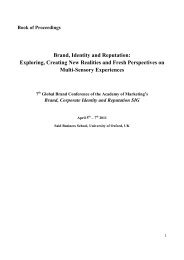You also want an ePaper? Increase the reach of your titles
YUMPU automatically turns print PDFs into web optimized ePapers that Google loves.
1.3 Objective<br />
i. To analyze the corrosion behavior of cutting tool material (carbon steel and<br />
tungsten carbide) in tannic acid by electrochemical method<br />
ii. To determine corrosion rate of tool steel by using Polarization Resistance and<br />
Tafel Technique under Gamry Instrument Framework Software<br />
iii. To evaluate the effect of pH, concentration and temperatures of tannin acids<br />
to the corrosion behavior of cutting tool material<br />
iv. To identify composition element in cutting tool material that influence its<br />
1.4 Scope<br />
corrosion behavior<br />
The scope of this project is study about the corrosion mechanism of the cutting tool<br />
in the wood industry which cause by tannic acids. The sample uses are three different<br />
types of carbon steel and tungsten carbide. The tannic acids will be prepared in<br />
different type solution. This sample will be immersed in tannic acids for different<br />
temperature. The corroded samples were viewed by optical microscope. The all<br />
corrosion test is control under Gamry Instrument Framework Software with Tafel<br />
Technique and Polarization Resistance Method. Through Tafel graph, the data can<br />
interpret from the Tafel plot such as corrosion current density and corrosion potential<br />
of corroded system. Analysis on corroded microstructure will include in this project.<br />
1.5 Problem Statement<br />
Obviously, the cutting tools in the wood industry often suffer from corrosion. These<br />
is due to wood industry are poor knowledge on degradation phenomenon of tools in<br />
contact with wood. It shows that different woods have a different corrosive impact. It<br />
is very difficult to know which type of cutting tool to use for sawing the various type<br />
of wood which contain different concentration tannic acid. So, it is important to learn<br />
more about the corrosive agent of different woods.<br />
3
















